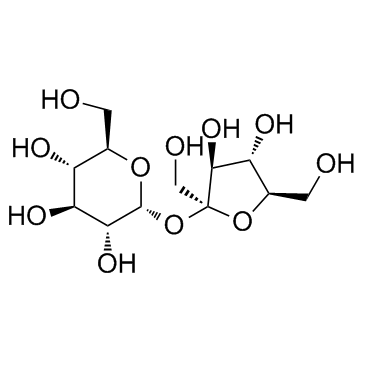Sucrose (D-(+)-Saccharose) |
| Catalog No.GC31352 |
Le saccharose (D-(+)-Saccharose) (D-(+)-Saccharose) est un disaccharide composé de deux monosaccharides, le glucose et le fructose.
Products are for research use only. Not for human use. We do not sell to patients.

Cas No.: 57-50-1
Sample solution is provided at 25 µL, 10mM.
Sucrose is a disaccharide which is composed of two monosaccharides, glucose and fructose.
Sucrose is a disaccharide which is composed of two monosaccharides, glucose and fructose. Compare to chow-feeding, high-energy (HE)-feeding results in an overall decreased preference for Sucrose solutions in both strains. Specifically, obesity-prone (OP) rats prefer 0.3 M and 1.0 M Sucrose solutions less during HE-feeding relative to chow-feeding (P=0.046 and P=0.012, respectively). As well, obesity-resistant (OR) rats exhibit decreased preferences for 0.01 M, 0.03 M, and 1.0 M Sucrose when HE-fed compare to chow-fed counterparts (P
[1]. Duca FA, et al. Effect of diet on preference and intake of sucrose in obese prone and resistant rats. PLoS One. 2014 Oct 20;9(10):e111232.
Animal experiment: | A total of 66 male 8-wk-old Sprague-Dawley obesity-prone (OP) and obesity-resistant (OR) rats (n = 38 per each phenotype), weighing 275 g and 210 g respectively, are used in this study. After recovery and attaining pre-surgical weights, rats undergo three training trials of 60-min sham feeding sessions with 0.03 M Sucrose solution. During testing, rats are briefly deprived of water (0900 to 1600 h) but not food, and are tested for 1 h (1400 to1500 h) sham intake of 0.03 M Sucrose solution until a stable baseline is achieved. Afterwards, rats are sham fed one of three Sucrose solutions (0.03, 0.3, and 1.0 M) in random order, every other day, with each concentration tested at least twice. Sucrose intake is individually recorded every 5 min for 60 min[1]. |
References: [1]. Duca FA, et al. Effect of diet on preference and intake of sucrose in obese prone and resistant rats. PLoS One. 2014 Oct 20;9(10):e111232. | |
| Cas No. | 57-50-1 | SDF | |
| Canonical SMILES | O[C@H]1[C@H](O)[C@@H](CO)O[C@H](O[C@]2(CO)O[C@H](CO)[C@@H](O)[C@@H]2O)[C@@H]1O | ||
| Formula | C12H22O11 | M.Wt | 342.3 |
| Solubility | Water : 100 mg/mL (292.14 mM) | Storage | Store at -20°C |
| General tips | Please select the appropriate solvent to prepare the stock solution according to the
solubility of the product in different solvents; once the solution is prepared, please store it in
separate packages to avoid product failure caused by repeated freezing and thawing.Storage method
and period of the stock solution: When stored at -80°C, please use it within 6 months; when stored
at -20°C, please use it within 1 month. To increase solubility, heat the tube to 37°C and then oscillate in an ultrasonic bath for some time. |
||
| Shipping Condition | Evaluation sample solution: shipped with blue ice. All other sizes available: with RT, or with Blue Ice upon request. | ||
| Prepare stock solution | |||

|
1 mg | 5 mg | 10 mg |
| 1 mM | 2.9214 mL | 14.6071 mL | 29.2141 mL |
| 5 mM | 0.5843 mL | 2.9214 mL | 5.8428 mL |
| 10 mM | 0.2921 mL | 1.4607 mL | 2.9214 mL |
Step 1: Enter information below (Recommended: An additional animal making an allowance for loss during the experiment)
 g
g
 μL
μL

Step 2: Enter the in vivo formulation (This is only the calculator, not formulation. Please contact us first if there is no in vivo formulation at the solubility Section.)
Calculation results:
Working concentration: mg/ml;
Method for preparing DMSO master liquid: mg drug pre-dissolved in μL DMSO ( Master liquid concentration mg/mL, Please contact us first if the concentration exceeds the DMSO solubility of the batch of drug. )
Method for preparing in vivo formulation: Take μL DMSO master liquid, next addμL PEG300, mix and clarify, next addμL Tween 80, mix and clarify, next add μL ddH2O, mix and clarify.
Method for preparing in vivo formulation: Take μL DMSO master liquid, next add μL Corn oil, mix and clarify.
Note: 1. Please make sure the liquid is clear before adding the next solvent.
2. Be sure to add the solvent(s) in order. You must ensure that the solution obtained, in the previous addition, is a clear solution before proceeding to add the next solvent. Physical methods such as vortex, ultrasound or hot water bath can be used to aid dissolving.
3. All of the above co-solvents are available for purchase on the GlpBio website.
Quality Control & SDS
- View current batch:
- Purity: >98.00%
- COA (Certificate Of Analysis)
- SDS (Safety Data Sheet)
- Datasheet
Average Rating: 5 (Based on Reviews and 24 reference(s) in Google Scholar.)
GLPBIO products are for RESEARCH USE ONLY. Please make sure your review or question is research based.
Required fields are marked with *



















